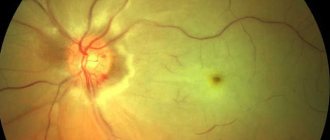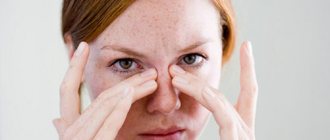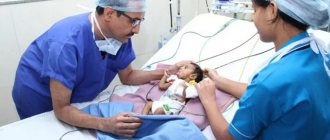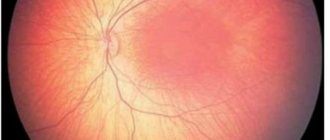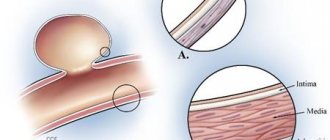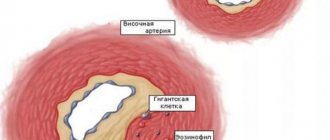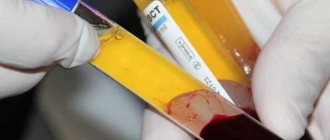Indications for use
It is worth considering that eye drops can be used for the following reasons:
- mechanical impact that led to injury;
- injuries of any etiology;
- rupture of the ocular vessels;
- diseases of hematological etiology;
- hypertension;
- atherosclerosis;
- diabetes mellitus and other diseases of the endocrine system;
- blood diseases and blood clotting disorders;
- ophthalmological diseases – iritis, uveitis;
- pathological changes in the retina.
Hemorrhage that occurs as a result of injury requires immediate medical examination. Such manifestations should not be ignored. With the help of special diagnostics, the doctor will be able to determine the etiology of such lesions.
Prevention
It is impossible to completely protect against subconjunctival and other types of hemorrhage. This is explained by a large number of predisposing factors. There are a number of ways to reduce the risk of this pathology:
- You should not abuse cigarettes and alcoholic beverages.
- Excessive loads should be avoided whenever possible.
- Human immunity is of great importance. To maintain it, it is recommended to take immunostimulating drugs and foods rich in vitamin C.
- People suffering from diabetes need to constantly monitor their blood sugar levels.
- With hypertension, patients should be attentive to their blood pressure and, if the levels are elevated, take medications in a timely manner.
- Retinal hemorrhage can be avoided by reducing the increased load.
In addition to all the above methods of prevention, every person should regularly visit ophthalmology offices.
List of the best drops for hemorrhage
Considering the cause of such unpleasant symptoms, the doctor prescribes certain ophthalmic solutions in the form of drops. It is worth considering that they can only be used after a doctor’s prescription and follow the recommendations in the instructions. If adverse reactions develop, you should stop treatment and consult an ophthalmologist.
Emoxipin
The active ingredient of this medicine is methylethylpyridinol. Therefore, the drops have such a pronounced medicinal effect:
- produce an antioxidant effect;
- help strengthen the walls of blood vessels;
- influence the normalization of blood clotting;
- reduce the risk of blood clots.
The drug has the ability to effectively eliminate hemorrhage. But there is a significant drawback - the risk of developing an allergic reaction. This causes itching, burning, and redness of the conjunctiva. The course of treatment lasts 1 month. Emoxipin should be instilled 1 drop 4 times a day.
When using several ophthalmic drugs, the interval between them should be 10-15 minutes. These drops are instilled last.
Taufon
The drug is widely used in ophthalmology.
The active substance is the amino acid taurine. This component accelerates the regenerative processes of the mucous membrane and tissues of the eyeball. Additionally improves the functioning of membrane cells. Helps quickly eliminate hemorrhage and improve the patency of nerve structures. In most cases, they are prescribed to eliminate the consequences that arose after a blow. Sometimes Taufon can cause an allergic reaction. Instill 1-2 drops 3 times a day. The course of drug therapy is 30 days.
Vixipin
The composition of this drug is similar to Emoxipine. Its use helps strengthen blood vessels. Prescribed for the prevention of thrombosis. Thanks to such actions, the elimination of hemorrhage is accelerated. Among the contraindications, it should be noted the presence of individual intolerance or hypersensitivity to the composition. It is prohibited for women to take during pregnancy and lactation.
Standard dosage: 1 pot 4 times a day. Treatment usually lasts 30 days, but in some cases it can be extended to 6 months.
Albucid
Antibacterial drops popular in ophthalmology. They have a pronounced anti-inflammatory effect. Prescribed for inflammatory, bacterial eye damage. Effectively help eliminate hemorrhage. Pharmacology offers a solution for children (20%) and adults (30%). Instructions for use: Albucid is instilled 2 drops 5 times a day, observing hygiene rules. The drug is well tolerated.
Potassium Iodide
This drug contains potassium iodide. This substance has a pronounced antimicrobial, antiseptic, and antiatherosclerotic effect. This promotes rapid resorption of blood clots. Treatment lasts 2 weeks. It is necessary to instill 1 drop 2 times a day. It is forbidden to take Potassium Iodide to patients with nephritis or thyroid dysfunction. Take only after doctor's prescription.
Diclofenac
The name of this drug is familiar to many.
The main substance is sodium diclofenac. This component helps quickly eliminate hemorrhage, reduces swelling, redness, and pain. After the first instillation, a short-term burning sensation, uncontrolled lacrimation, redness, and an allergic reaction may occur. Interaction with drugs based on acetylsalicylic acid is prohibited. Use Diclofenac 4 times a day, 1 drop. Treatment lasts 2 weeks.
Hyphenation
This drug is usually used as an adjuvant therapy. The active ingredient is hydroxypropyl methylcellulose. Thanks to this substance, the mucous membrane is moisturized. In addition, it produces a protective function for tissues. Complex treatment with other ophthalmic drops speeds up the process of eliminating hemorrhage.
Promotes regeneration of mucous membranes and tissues. You can instill Defislez 8 times, 2 drops each. At the same time, maintain a certain time interval between instillations.
How to treat
When blood comes from the eye, this is a sign of one or another pathology. However, each case requires an individual approach to therapy, so the patient must undergo an initial examination and diagnosis by an ophthalmologist. Hyposphagma, hyphema and hemophthalmos of the eye require different medications.
For hemorrhage into the conjunctiva of the first and second degree, no specialized measures are required. After some time, the bloody spot will disappear on its own. Doctors note: in the absence of pain, the feeling of a foreign body in the eye and a decrease in the quality of vision, a person may not seek medical help.
For third-degree hyposphagma, drug therapy is often prescribed, thanks to which the patient will block discomfort and pain.
Treatment of hemorrhage in the retina or another part of the eye requires an integrated approach. In this case, not only the visible manifestations of the pathology are taken into account, but also its cause.
In severe cases, it is no longer possible to restore partially or completely lost vision.
If characteristic symptoms appear (bloody spots in the eye, pain and blurred vision), the person should immediately go to the hospital. The primary task of the doctor is to stop the bleeding as quickly as possible. Do not touch blood clots - they dissolve on their own.
Important information: On what day after conception does implantation bleeding occur and how many days does it last?
If a single case of hyphema or hemophthalmos of the eye occurs, treatment includes rest, rest and unloading of the eye muscles.
In case of retinal bleeding, the patient requires hospitalization. If symptoms persist beyond 10 days, surgery may be required.
Pharmacy drugs
Self-therapy with medications is strictly prohibited. They should only be prescribed by a doctor. For this pathology, the most effective dosage form is eye drops. They are topical medications, so they give a quick effect.
You need to use the drops correctly:
- Before the procedure, be sure to wash your hands. It is best to use a bactericidal agent.
- For more comfortable instillation, you should take a lying position, but this is not always possible. Doctors emphasize that you can instill eye drops in a sitting position, with your head tilted back.
- You need to hold the bottle in one hand, and with your free hand you should pull down the lower eyelid and hold the upper one.
- If several types of drops are prescribed, the break between uses should be at least 20-30 minutes.
The selection of suitable medications is carried out by the attending physician. This may be one medicine or several.
For hemorrhage in the retina, treatment may require the administration of medications for pressure inside the eye, in which case Atropine and Thymol are prescribed.
Potassium iodide 3%. This drug is prescribed if subconjunctival hemorrhage and other pathologies are detected. The product is characterized by the presence of antiatherosclerotic and antimicrobial properties. Under the influence of potassium iodide, blood clots are rapidly dissolved. Glycerol has a similar effect.
Emoxipin. This medicine contains methylethylpyridinol hydrochloride. This substance promotes:
- rapid resorption of hemorrhages;
- increases blood clotting, thereby stopping bleeding;
- strengthening the walls of blood vessels.
Emoxipine is often prescribed in combination with other medications.
Emoprox 1%. This drug is an analogue of Emoxipine and has a similar composition and medicinal effect. It gives good results for different types of eye hemorrhage; treatment should be prescribed by a doctor.
Diclofenac. These eye drops help quickly block symptoms:
- have an anesthetic effect for pain;
- relieve inflammation;
- promote rapid resorption of blood stains.
The duration of use depends on the severity of symptoms.
Taufon. The medicine contains the amino acid taurine. Thanks to this component, regeneration processes are accelerated in damaged tissues of the eyeball. This gives grounds to prescribe Taufon drops for injuries to the organ of vision and contusions.
Visine 0.05%. Such drops are prescribed for many pathologies that cause hemorrhage. Visine is able to remove all irritants that negatively affect eye tissue. Under the influence of active substances, bruises resolve.
Albucid. If the pathology was caused by inflammatory processes, Albucid drops are often prescribed. They have an antibacterial effect and quickly eliminate pathogens.
Hyphenation. The active ingredient used here is hydroxypropyl methylcellulose. Its action is aimed at:
- protecting the cornea from negative external influences;
- moisturizing the epithelium;
- relieving discomfort associated with the feeling of a foreign body in the eye.
Home Remedies
Doctors emphasize that you need to carefully use home remedies to eliminate hemorrhage in the eye - the causes and treatment of this pathology vary. It is possible to refuse drug therapy only if the person has no pain and visual acuity is not impaired.
First of all, you need to give your eyes rest and avoid heavy physical activity. Traditional medicine will help you quickly get rid of red spots. Eye lotions are especially effective in this case. A liquid (decoction, infusion) is prepared for them and cooled. After this, cotton pads or pieces of cotton wool are soaked in the liquid and placed on the eyes. At this time, it is best to rest and lie down. The duration of the procedure is 15-20 minutes.
Important information: Bleeding (blood) from the anus (butt) during bowel movements in late pregnant women
Tea lotions. This method can be called the simplest and fastest. To do this you will need strong brewed tea. It relieves swelling and discomfort, promotes rapid tissue restoration.
Chamomile decoction. For 250 ml of water take 2 tbsp. l. dried chamomile flowers, bring to a boil and leave to cool under the lid.
Vinegar water. You should be careful with this product. For 1 syllable l. water requires 1 drop of vinegar 9%. The dosage should not be exceeded, as this may negatively affect the condition of the mucous membrane.
Mild swelling and redness can be treated with ice cubes. Water is poured into molds and sent to the freezer. These pieces can be used to wipe the area above and below the eyes. Ice helps to constrict blood vessels and tones tissues. Instead of water, you can take a decoction of chamomile or other medicinal herbs.
The use of compresses has a good effect.
Cottage cheese compress. To do this you will need chilled cottage cheese (from the refrigerator). A spoonful of fermented milk product is wrapped in several layers of bandage or gauze and applied to the eyes. Within 10-15 minutes the swelling will subside. With the help of such compresses you can speed up the restoration of tissue in the eyeball.
Cabbage compress. Cabbage is often used to combat inflammation, swelling and pain in soft tissues. To do this, the cooled cabbage leaf needs to be slightly mashed to release the juice. This compress should remain on your eyes for about 1-15 minutes.
You can use home remedies and drops at the same time - with complex therapy, the effect occurs faster.
What not to do
If subconjunctival hemorrhage is detected, you need to fully control the following actions:
- If your eyes are bleeding, you should not do the following: rub them and scratch them, trying to get rid of the foreign body sensation. In this case, an infection can occur, and symptoms of inflammation will be added to the symptoms of hemorrhage.
- You cannot select drops for treatment yourself. Each drug is aimed at solving one or more problems. The wrong medication will cause complications.
- If blood is flowing from the eye, it is not recommended to strain, you need to rest as much as possible.
Burial rules
When using eye drops, it is very important to follow a few basic rules. Proper use speeds up the healing process. Basic recommendations to follow:
- observe the rules of hygiene and sanitary standards;
- Before using the medicine, check the expiration dates; it is strictly forbidden to use expired medicines;
- it is forbidden to touch the tip of the bottle to the mucous membrane;
- strictly follow the dosage and treatment regimen prescribed by the doctor;
- make sure that the drops fall into the conjunctival sac;
- self-medication is prohibited;
- when using several eye medications, the interval between doses should be 10-15 minutes.
If adverse reactions occur, you should consult your doctor. If hypersensitivity to the drug develops, a safe analogue should be selected. Drops are necessary to strengthen the blood vessels of the eye structures.
Prevention of hemorrhage in the eye
In most cases, such unpleasant symptoms occur due to excessive eye strain. Therefore, to prevent such signs, physical and eye strain should be avoided. Proper and balanced nutrition will help strengthen blood vessels. A person must adhere to a healthy lifestyle. Smoking and alcohol negatively affect vision and blood vessels. Therefore, it is better to give up bad habits.
The basic rule for the prevention of ophthalmological diseases is timely consultation with a doctor. Self-medication is not recommended. This may cause negative consequences to develop. Hemorrhage can be localized to part of the membrane or affect the entire eye. In any case, you should remain calm and seek help from an ophthalmologist.
Source: proglazki.ru
Application area
In this article we will figure out what to do if blood vessels in the eyes burst and hemorrhage begins. Before starting treatment, the true cause of the unpleasant symptom should be established. Only mild forms of the disease, with minor damage to blood vessels and in the earliest stages, can be treated conservatively (with drops). However, even in this case, consultation with an ophthalmologist is strictly required.
Since hemorrhage in the eye is not always a consequence of injury, it is necessary first of all to carry out an extensive diagnosis and establish the extent and nature of the damage. Sometimes they become a consequence of eye pathologies or even systemic diseases. The most commonly identified causes of ocular hemorrhages include:
- Eye injuries. There are open and closed (blunt) injuries. In most cases, blunt trauma (contusion) occurs, in which bleeding in the eye can occur even with a normal blow to the head. There are 3 degrees of contusion: 1 (mild) – the structures of the eye are not damaged, the damage does not affect the functionality of the eye; 2 (medium) – minor damage to the ocular structures, vision decreases to light perception; 3 (severe) – the lesions are irreversible, complete loss of vision. The use of eye drops is most effective for grade 1 damage;
- General diseases of the body , which result in a violation of the elasticity and strength of blood vessels: atherosclerosis, arterial hypertension, diabetes mellitus, blood or connective tissue diseases, blood clotting disorders;
- Development of tumors . When intraocular tumors grow, compression and damage to blood vessels occurs;
- Progression of eye pathologies : uveitis, iritis, myopia. All these diseases ultimately contribute to the disruption of the integrity of the vascular wall in the eyes;
- Increased physical activity . Damage to blood vessels is often provoked by conditions in which increased physical stress is distributed specifically to the eyes: in women in labor with strong pushing, in patients with severe coughing (tuberculosis, asthma, pneumonia), with a sudden loud cry.
Sometimes the correct diagnosis and timely treatment of internal pathologies become the only correct solution when eliminating hemorrhage in the eye.
Causes
Hemorrhage in the eye is accompanied by seemingly unreasonable redness of the eyeball. The size of the spot may vary; in some cases the spot is barely noticeable, in others it covers the entire sclera. The reasons for increased vascular fragility are much deeper. This phenomenon can be a symptom of serious illness; repeated bleeding in the eye requires medical intervention.
Causes of hemorrhages in the eyeball:
- Arterial hypertension - the integrity of blood vessels is impaired due to a strong change in blood pressure against the background of a hypertensive crisis. Vessels rupture under the influence of high pressure, a fairly high probability of death;
- Diabetes mellitus - pathology manifests itself against the background of diabetic angiopathy, blood vessels burst due to increased blood sugar. The disease is accompanied by hemorrhages in the eye, a significant deterioration in visual function up to its irreversible loss. Vessels burst for no apparent reason, even with minor physical exertion;
- Penetration of infection into the tissue of the eyeball;
- Eye diseases - conjunctivitis, keratitis;
- Injuries of the eyeball of various etiologies;
- Bleeding disorders;
- Deficiency of important components - processes are accompanied by a decrease in elasticity, ruptures of blood vessels;
- Neoplasms - tumors localized near the eyeball contribute to compression and deformation of the vessel, as a result of which they are destroyed;
- Alcohol - abuse of alcoholic beverages provokes a sharp dilation and constriction of blood vessels, as a result of which they burst;
- Long-term use of medications - prolonged use of medications may be accompanied by bleeding.
Hemorrhages in the eye also occur due to visual strain, during prolonged periods of time at the computer, when reading small print, or when doing painstaking work.
This phenomenon is also observed against the background of increased stress, when lifting heavy objects, labor pains, and severe coughing. Capillaries can also rupture as a result of visiting a sauna or steam bath.
A single outpouring does not pose a danger to the body; medical assistance may be required only if the phenomenon occurs at least twice. In this case, you need to contact an ophthalmologist, the doctor will diagnose and prescribe treatment.
Features of the drugs
The selection of the necessary remedy, in particular drops, occurs only after an extensive examination and localization of the pathology. The term “bleeding in the eye” can have several clearly defined meanings, and in each specific case its own treatment will be prescribed:
- Hyphema. Hemorrhage in the anterior chamber of the eye, when clots begin to accumulate between the iris and cornea. There are 4 degrees of hyphema, depending on the degree of filling of the anterior chamber with blood. And if the initial stages (as well as microhyphema) can be treated conservatively, then more severe hemorrhages can only be eliminated surgically. For this type of pathology, treatment in a hospital is recommended, since recurrent hemorrhages often occur on days 3-5;
Read more about eye myopia here.
- Hemophthalmos. The appearance immediately behind the lens of a homogeneous formation with a brown color. The disease has severe consequences, including complete loss of vision. The main symptoms are impaired visual acuity, the appearance of flashes of light and dark moving spots in the field of vision. Treatment is carried out both with local drugs (eye drops) and systemic exposure. The intensity of therapy depends on the severity of the lesion; the mildest injuries can be treated outside the hospital;
- Retinal hemorrhage . Blood vessels can also be damaged in the retina. In this case, the bloody spot is on the white of the eye. Additional symptoms are the appearance of floaters, decreased visual acuity, and limited mobility of the eyeball. If the lesions are moderate in nature, then treatment is carried out using eye drops and general prescriptions. In case of extensive damage, the only treatment option is surgery;
- Hemorrhage into the orbital cavity . The cavity of the orbit (orbit) is directly connected to the eyeball, including blood vessels. Therefore, damage to the orbit always affects the quality of vision. Concomitant manifestations are hemorrhage into the conjunctiva and skin of the eyelids. There is deterioration of vision, double vision, and limited eye mobility. Conservative treatment combines the use of local drugs and systemic effects.
Conservative treatment, especially on an outpatient basis, for hemorrhage in the eye is possible only in the mildest cases of damage to the blood vessels. But even with such a degree of damage, consultation with an ophthalmologist is mandatory, since it may be necessary to treat not only eye injuries, but also a systemic disease that caused the hemorrhage.
The eye is filled with blood: causes, treatment methods, rehabilitation, prevention
Is your eye covered in blood? This is an external sign of bleeding in the eye. This is a general concept characterized by the entry of blood from a vessel into the membrane and environment of the eye. This is not the norm. This pathology can be caused by many reasons. Serious complications include lens displacement, retinal detachment and complete loss of vision. Let’s take a closer look at how to prevent complications.
Bleeding in the eye: what is it?
Eye bleeding or subconjunctival hemorrhage means that the eye is filled with blood, mainly in the front of the eyeball.
The external manifestations are: redness of the eye, blood accumulates in the front part between the colored iris and the transparent cornea.
Why is the eye filled with blood? A common cause is damage to a blood vessel after a blow or something sharp entering the eye.
The eye is filled with blood: reasons
The causes of blood leaking into the eye can be expressed in pathological serious diseases. This includes eye cancer, blood vessel diseases and inflammation of the internal parts of the eye.
Why does blood get into the eye? Consider common reasons:
- Damage to a blood vessel.
- A scratch on the cornea or a speck - for these reasons, characteristic redness and pain appear. If a foreign object gets into the eye and scratches the cornea, then discomfort occurs. Perhaps there is redness in the eye for this reason. Antibiotic eye drops will reduce the risk of infection.
- Inflammation of the iris - iritis - is a disease associated with the body's immune system.
- The choroid of the eye becomes inflamed - uveitis - a disease characterizing pathological changes in the immune system. The eyes are quite sensitive to light, and the image is blurry. An accompanying symptom is headache.
- Acute glaucoma is a serious eye disease characterized by a sharp increase in eye pressure. Severe redness, pain, blurred vision are typical symptoms.
- Corneal ulcers can be caused by bacterial or viral infections. The disease causes blood to appear in the eye. He becomes sensitive to light. Constant sensation of a foreign body in the eye. Bacterial sores are common in people who wear contact lenses.
- Eye injury.
- Increased blood pressure.
- After taking blood thinners.
- For a blood clotting disorder.
- After eye surgery (including laser vision correction).
- Dry eyes.
- When vision deteriorates.
In rare cases, a condition where the eye is filled with blood occurs during pregnancy. However, in this case there is no need to sound the alarm. After the birth everything will pass. It is necessary to consider each of the reasons in more detail.
A fairly common reason why the eye is filled with blood. There are many negative factors that provoke damage to blood vessels in the eyes, namely:
- Severe sneezing or vomiting can cause blood vessels to rupture.
- With heavy physical activity (lifting weights), rupture of the blood vessels in the eye is observed due to increased blood pressure.
- In case of eye injury.
- When wearing contact lenses. They can cause irritation and rubbing of the eyes. Therefore, eye bleeding is provoked.
- Various infections in the eye.
- For diabetes or blood clotting problems.
- After suffering severe stress and high blood pressure.
A blood vessel in the eye can become damaged after taking medications that affect blood flow.
Even the usual aspirin in large doses can cause a similar effect.
Hyposphagma
This condition is also called scleral hemorrhage. In medical terms, this is a subconjunctival hemorrhage. In this condition, the white of the eye is filled with blood: blood accumulates between the thin outer membrane of the eye and the white. People simply say: “a vessel burst.” Indeed, this is the first reason why the eye becomes bloodshot.
There are other negative factors:
- direct traumatic impact to the eyeball: friction, impact, sudden jump in barometric pressure, foreign body entering the eye and due to chemical exposure;
- increased arterial and venous pressure: sneezing, coughing, physical activity, bending over, pushing during childbirth, tension during constipation, intense crying in the child;
- reduced level of blood clotting: congenital and acquired hemophilia, use of antiplatelet and anticoagulant medications (aspirin, Heparin, Plavix, etc.);
- infectious diseases (hemorrhagic conjunctivitis, leptospirosis);
- fragility increases in blood vessels due to diabetes mellitus, atherosclerotic disease, deficiency of vitamins C and K, systemic connective tissue diseases (systemic lupus erythematosus, autoimmune vasculitis);
- after surgical intervention in the organ of vision.
All symptomatic signs appear externally as a blood-red defective spot on the white membrane. Gradually the color does not change, but only becomes lighter until it disappears completely. Rarely, the phenomenon is accompanied by the discomfort of a feeling of the presence of a foreign body, itching.
You can speed up the disappearance and resorption of this hemorrhage.
Method 1: if the hemorrhage increases in size, then it is effective to use vasoconstrictor eye drops (Vizin, Naphthyzin).
Method 2: Potassium iodide eye drops will help speed up resorption.
A single hemorrhage usually occurs without inflammation. The following symptoms may occur: “floaters” before the eyes, decreased focus of vision. If the hemorrhages are constant, then this is an alarming signal about a serious disease of the eye or the body in particular. It is necessary to urgently contact a specialist to diagnose a possible pathology.
Hyphema
The anterior chamber of the eye is the area between the cornea (the clear convex lens of the eye" and the iris (the disk with the pupil in the center that gives the eye its unique color) with the lens (the clear lens behind the pupil). The normal condition is when this area is filled with a clear liquid. The appearance of blood leads to to hyphema or hemorrhage in the anterior chamber of the eye.
The reasons for the appearance of this condition of the organ of vision can be different, even sometimes unrelated to each other. Conventionally, experts divide the reasons into three groups:
1. Trauma is a common cause.
- Penetrating trauma - damage to the eye with a sharp object, less often from the action of a blunt object. The internal contents of the eyeball and the environment are damaged.
- Non-penetrating injury - the integrity of the internal structure of the eye is destroyed. This leads to hemorrhage of the eye into the anterior chamber. Most often the cause is the result of impact with a blunt object.
- All types of surgery on the organs of vision are accompanied by hyphema.
2. Diseases of the eyeball are usually accompanied by the formation of new defective vessels inside the eye. These vessels have defects in their structure, so the risk of their fragility increases. Usually this condition is a consequence of the following reasons:
- diabetes;
- retinal vein blockage;
- retinal detachment;
- intraocular tumors;
- inflammatory diseases of the internal structures of the eye.
3. Diseases of the body in particular:
- for chronic alcohol and drug intoxication;
- in case of blood clotting disorders;
- for oncological diseases;
- for systemic connective tissue diseases.
Hyphema can be divided into four stages of damage:
- 1st degree: visually the anterior chamber of the eye is one third;
- 2nd degree: blood fills the anterior chamber of the eye to half;
- 3rd degree: the chamber of the eye is filled with blood more than half;
- 4th degree: completely filled with blood, “black eye” condition.
This classification is more than conditional.
The degree of hyphema damage is determined by symptoms:
- visual determination of blood fullness of the anterior chamber of the eye;
- visual acuity decreases (especially in a lying position);
- fear of bright light;
- painful sensations.
Diagnosis of the disease consists of a visual examination, tonometry (measuring intraocular pressure), visometry (establishing visual acuity), biomicroscopy (an instrumental method using a special microscope).
Blood poured into the retina
Behind the vitreous body of the eye there is a retina. It is responsible for the perception of light. Behind it is the choroid, in which there are blood vessels.
The manifestation of bleeding into the retina boils down to the fact that visual acuity, sometimes a certain field of vision, sharply decreases. Usually no pain or discomfort is felt.
Retinal hemorrhages are classified into three degrees:
- with a mild degree, slight swelling of the cornea or retina is noticeable, the tissue is not damaged;
- in moderate cases, swelling occurs with damage to the tissue of the eyeball;
- in severe cases, the retina and its vessels are torn; the lens is often damaged; severe degrees can lead to complete loss of vision.
In case of frequent relapses, it is necessary to undergo treatment in a specialized hospital. A surgical method of intervention is often used - laser coagulation.
The eye was filled with blood after the blow: first aid
A blow to the eye most often provokes hemorrhage. If the eye is filled with blood, first aid should be provided immediately. First of all, it is necessary to characterize the injury:
- If the injury is caused by a blunt object, then it is necessary to put a bandage over the eye. Moisten it in cold water in advance, then apply ice wrapped in a towel.
- If there is a cut injury, it is necessary to cover the eyelid with a sterile bandage. Secure the bandage with adhesive tape. It is recommended to bandage both eyes. To prevent synchronous movement of the organs of vision, which causes pain. After that, head to the hospital.
- If the eye is injured, severe bleeding may occur. The bleeding needs to be stopped. To do this, cover your eye with a clean cloth or scarf. Then take the victim to a doctor.
Providing first aid for an eye injury should be as careful as possible. Because it can cause harm. Anti-inflammatory therapy reduces the likelihood of complications.
What not to do if a squirrel is swimming in blood
First aid must be provided, but carefully. You need to know what is contraindicated to do in case of eye injury:
- Do not rub or put pressure on the injured eye. Otherwise, the condition may only get worse.
- If a foreign body gets into the eye, you cannot remove it yourself. It is better to have this done by a qualified specialist.
- If the eye injury is penetrating, then you cannot rinse it with running water. Otherwise, you can get a dangerous infection in your eye.
- Do not use cotton wool when bandaging. Its villi will aggravate the condition.
When providing first aid at home, the main thing is to do no harm.
List
Unfortunately, today there are no effective drugs that can combat ocular hemorrhage. For mild lesions, the doctor may recommend complete rest and the use of certain eye drops that have a general strengthening and health-improving value. These medications stimulate metabolism in damaged tissues and their regeneration, thus promoting their restoration and renewal.
Such funds include:
- Eye drops Potassium iodide 3%. The main active ingredient is potassium iodide, which has antiatherosclerotic and antimicrobial effects. One of the main drugs used in the treatment of damaged eye vessels. In addition to the antiseptic effect, it promotes the resorption of hemorrhages and has antifungal activity. The drug is not prescribed to patients with impaired thyroid function, with a diagnosis of nephritis or nephrosis, with certain skin lesions, during pregnancy and lactation, and newborn children;
Instructions for use of Potassium Iodide eye drops can be found here.
- Emoprox 1%. The main active ingredient is methylethylpyridinol hydrochloride, which has a number of medicinal properties: angioprotective (vasodilator), antiplatelet (prevents the formation of blood clots), antihypoxic (increases resistance to hypoxia), antioxidant (suppresses oxidation). Contraindications include individual intolerance, as well as periods of pregnancy and lactation;
- Emoxipin drops 1%. An analogue of Emoprox, with the same active ingredient. Stimulates the resorption of hemorrhages, helps strengthen vascular walls, and improves rheological parameters of blood. The list of contraindications is the same as that of the analogue;
- Diclofenac drops 0.1%. The main active ingredient is diclofenac sodium, which has analgesic and anti-inflammatory effects. Used as part of complex therapy for penetrating or blunt eye injuries. In case of hypersensitivity to the components of the drug and other NSAIDs, treatment with Diclofenac is not carried out, as well as with its analogues: Diclof, Naklof;
- Taufon 4%. The active substance is taurine, a sulfur-containing amino acid formed in the body during the conversion of cysteine. It is a stimulator of regenerative and reparative processes in case of injuries, restoration and normalization of metabolism. The only contraindication is individual intolerance; use with caution is recommended during pregnancy and lactation, as well as for children under 18 years of age; You can learn about the use of Taufon eye drops in the article.
- Hyphenation. The main active ingredient is hydroxypropyl methylcellulose, which provides high viscosity to the medicinal product, as a result of which the drug covers the surface of the eyeball with a film that lubricates and softens the cornea. According to the instructions of Defislez, the consequence of using the drops is the complete restoration of eye tissue within 2-3 weeks. Significant improvement is achieved already on days 3-5;
- Visine 0.05%. The drug belongs to the group of alpha-adrenergic agonists and is designed to eliminate eye irritations of various nature: physical, chemical, allergenic. Contraindications to the use of the drug are hypersensitivity to its components, corneal dystrophy, angle-closure glaucoma, children under 2 years of age.
Determining the extent of damage, as well as drawing up a treatment regimen for hemorrhage in the eye, is the prerogative of only an ophthalmologist. Even if the lesions are minor, a preventive examination has never harmed anyone, and the benefits from it can be invaluable.
Recommendations for use
If your injuries are minor and the hemorrhage occupies a small area, then it is quite possible that your doctor will recommend outpatient treatment.
Drops for red eyes
Antibiotic eye drops are described in this article.
Eye drops for conjunctivitis https://eyesdocs.ru/medicinaoperacii/lekarstva/kakie-kapli-dlya-glaz-luchshe-ispolzovat-pri-konyunktivite.html
In this case, you will have to instill eye drops yourself. But for the treatment to be effective, you should pay attention to some nuances that are mandatory when carrying out the procedures yourself:
- Use only drugs with a verified expiration date. Otherwise, you may experience additional visual impairment;
- If using a dropper or inline dropper, be sure to boil it for at least 30 minutes. Carry out the same treatment before each procedure (for a built-in dropper, a closed cap will be sufficient);
- If the bottle is equipped with a dropper, inspect its tip for sharp edges or burrs to avoid accidental injury;
- Before the procedure, wash your hands with soap;
- Take a comfortable position and with one hand slightly pull down the lower eyelid, and with the other, without touching the dropper to the eye, drop from the bottle into the resulting “pocket”;
- Apply no more than 1 drop at a time. If it is necessary to instill a larger amount, take a break of at least 3 minutes. ;
- If you need to use different eye products, take a break between their use of at least 30 minutes. , and add ointments last;
- Strictly follow the dosage and administration of medications. Both decrease and increase in this matter are quite dangerous;
- When purchasing, always check that the prescribed and purchased drug corresponds, since there are drops with the same name and different purposes (ear, for the common cold).
If even during initial use the drops cause a strong feeling of discomfort, you should not tempt fate - perhaps you are intolerant. Rinse your eyes thoroughly and try to see an ophthalmologist as soon as possible.
Source: EyesDocs.ru
Causes of hemorrhage
Bleeding in the eye occurs due to damage to the small blood vessels in the organs of vision. Violation of the integrity of the vascular wall can occur under the influence of a number of factors. Most often, this pathology is traumatic in nature, developing as a result of injury to the organs of vision, head and even chest or torso. Ophthalmic hemorrhage can occur even with minor damage (contusion).
In addition to traumatic injuries, the following factors can provoke hemorrhage inside the ocular structure:
- oncological processes;
- blood clotting disorder;
- viral inflammation of the eye mucosa;
- taking medications that thin the blood;
- lack of vitamin K in the body;
- diabetic retinopathy;
- atherosclerosis;
- microaneurysms;
- hypertension;
- endarteritis;
- retinal defects;
- anemia and other blood diseases;
- myopia;
- connective tissue pathologies.
The cause of intraocular hemorrhage can be excessive physical activity, which includes not only increased strength loads, but also pushing during childbirth, severe coughing and profuse vomiting in some diseases. A loud cry can also cause blood to accumulate in the eye cavity.
Features of treatment
Eye drops for hemorrhage are used in mild forms of pathology, when damage to blood vessels is minor. Therapy is selected only after a detailed examination, identifying the cause and characteristics of the development of the pathological phenomenon. In the selection of medications, the location of ophthalmic hemorrhage plays an important role. The following forms of intraocular hemorrhage are distinguished:
- Hyphema. Accumulation of blood is observed throughout the cavity of the anterior chamber of the eye. Most often it occurs as a result of contusion and is manifested by severe pain and blurred vision. The blood formation in the eye has a uniform red consistency with smooth contours. There are 4 stages of hyphema development. Small blood clots quickly resolve with eye drops, but large hyphemas that cover almost the entire pupil require surgical intervention.
- Hemophthalmos. Hemorrhage occurs inside the vitreous body and is characterized by the formation of a homogeneous brown formation directly behind the lens. Taking into account the degree of damage, partial (deterioration of vision due to complications) and complete (complete loss of vision) hemophthalmos are distinguished. The disease is manifested by the following symptoms: flashes of light, scotomas, blurred vision, decreased visual acuity. This form of hemorrhage is the most dangerous and, if left untreated, can cause retinal detachment or atrophy of the eyeball, which ultimately leads to complete loss of vision. Drops are prescribed for bleeding in the eyes; in severe cases, surgical intervention is performed.
- Extravasation into the retina. In case of damage to the retinal vessels, a bloody spot forms in the white of the eye. The pathology is manifested by the following symptoms: blurred image, flickering “spots” before the eyes, the formation of a grid, deterioration in the quality of vision. Extensive hemorrhages lead to vision loss and can cause the development of retinopathy. Moderate lesions are treated with eye drops, extensive hemorrhages are eliminated surgically.
- Extravasation into the orbital cavity . The pathology occurs as a result of contusion of the orbit of the eye, against the background of blood pathologies or as a result of vasculitis. Hemorrhages are additionally observed in the conjunctiva and skin of the eyelids. Ocular hemorrhages are accompanied by the following symptoms: diplopia, limited pupil mobility, blurred vision, severe bulging eyes. Treatment of this form is carried out through systemic exposure and the use of eye drops.
In any form of the disease, the white of the eye turns red. The degree of redness depends on the severity of the hemorrhage. When the first signs of ophthalmic hemorrhage appear, you should consult an ophthalmologist. Quick diagnosis to detect the cause and select effective treatment. In addition to bed rest, cold compresses and bandages with an antiseptic, drug therapy is prescribed, which includes a number of drugs aimed at strengthening blood vessels and stopping the blood.
What does blood on the eye mean? What to do if your eye is filled with blood? Causes and treatments
Subconjunctival hemorrhage
Eye bleeding (subconjunctival hemorrhage) is bleeding in the front of the eyeball. It can cause the eye to become red or even cause blood to accumulate at the front of the eye between the clear cornea and the colored iris.
Bloodshot eyes are usually caused by a damaged blood vessel. In severe cases, the same cause that damaged a small blood vessel can lead to other intraocular injuries: lens displacement, traumatic cataract, globe perforation, vitreous hemorrhage, retinal detachment, and optic atrophy.
Causes
Bleeding is most often caused by trauma, such as trauma from a blunt object or penetration by something sharp. Other causes of bleeding in the eye include malformations of the blood vessels, cancer of the eye, or severe inflammation of the inner parts of the eye.
Common reasons
- Blood thinners
- Attacks of suffocation
- Severe vomiting
- Lifting weights
- Hypertension (high blood pressure)
- Sneezing or coughing, especially if it is prolonged or painful
Damaged blood vessel
There are many factors that cause damage to the blood vessels in the eyes, causing them to become bloodshot. Here are some of these factors:
- Severe sneezing, coughing or vomiting can cause blood vessels to rupture. These symptoms may be accompanied by severe vomiting.
- Heavy physical activity, such as heavy lifting, can cause blood vessels in the eyes to rupture due to increased pressure after straining. Due to high pressure in the head vessels, small capillaries rupture.
- Eye injury.
- Contact lenses can irritate your eyes, especially if chafing occurs. This can lead to rupture of blood vessels.
- A sudden increase in blood pressure due to a minor injury can cause capillaries to rupture, causing eye bleeding.
- Eye infections can cause damage to blood vessels.
- Eye surgery can also affect the blood vessels in the eyes and cause infection.
- Diabetes or blood clotting problems are known to affect blood vessels.
- If you are prone to high blood pressure in general, and if you are often under stress, this may be causing the blood vessels in your eyes to rupture.
- Additionally, if you are taking blood thinners or any other medications that affect blood flow, they may also cause damage to blood vessels. Even high doses of aspirin can have this effect.
The eye is swollen with blood and hurts
If the bleeding is accompanied by painful sensations, the most likely cause is one of the following conditions:
A scratch on the cornea or a speck in the eye
In most cases, redness and soreness in the eyes is caused by debris getting into the eyes. If she scratches her eye, there may be a feeling of discomfort. After removal of the foreign body, relief occurs.
Note.
You may be prescribed antibiotic eye drops or ointment to reduce the risk of infection.
Iritis (inflammation of the iris) or anterior uveitis (inflammation of the choroid)
These diseases can sometimes be caused by a problem with the immune system or an infection.
In addition, you may notice that your eyes become sensitive to light, blurred vision, and a headache.
Acute glaucoma
This is a serious condition that causes a sudden increase in eye pressure, as well as severe redness and pain. Vision may be blurry and cloudy.
Ulcer on the cornea
Usually caused by a bacterial or viral infection, it can cause the eye to become red and sensitive to light, as well as a feeling that there is something in the eye. Bacterial corneal ulcers are commonly seen in people who wear contact lenses.
Blood bubble in the eye
A blood blister in the eye is also known as subconjunctival hemorrhage. Its occurrence may cause concern, however, it is not a serious problem.
Although the source cannot always be determined, some potential causes of subconjunctival bleeding include:
- Eye injury
- A sudden increase in blood pressure, which can be caused by heavy lifting, coughing, sneezing, laughing, and constipation
- Blood thinners such as aspirin (acetylsalicylic acid) and warfarin
- Rarely, a blood clotting disorder or deficiency of vitamin K (it helps the proteins needed for blood clotting to function properly)
- Eye surgery, including laser vision correction and cataract removal
Note : If you do not have any of the above reasons, but the bleeding continues, you should see a doctor to make sure there is no problem with the eyeball, high blood pressure or circulatory problems.
During pregnancy
Sometimes, during pregnancy, the problem of eye bleeding may arise, but do not worry, as after childbirth it will go away on its own. Some of the common problems may include:
Dry eyes
Hormonal changes cause the body to produce fewer tears, causing the eyes to become dry, leading to irritation, redness, and sensitivity to light.
In order to alleviate your condition, you need to minimize the time you spend in front of a computer or TV screen, avoid exposing your eyes to fluorescent lamps, stop using contact lenses, and also control the humidity in the room.
Visual impairment
During pregnancy, swelling of the cornea occurs, so temporary discomfort from contact lenses, as well as decreased vision, is possible. This case does not require treatment; after childbirth, vision will return to normal.
Treatment
Most often, no treatment is needed unless the condition is caused by injury or infection. The blood in the eye will disappear on its own in a few days or a couple of weeks, depending on the amount of blood. To speed up this, drops from the “artificial tear” category can be used up to 6 times a day. But it is important to exclude serious causes, especially if the situation recurs.
Common diagnostic tests and procedures include:
- Complete blood count to determine platelet count
- Blood chemistry to measure total serum protein
- Coagulopathy tests to evaluate blood clotting functions
- Blood pressure
- Urinalysis to rule out kidney disease
- X-ray of the chest and abdomen
Diagnostic ultrasound (ultrasound) to examine the front of the eye and confirm/exclude the possibility of retinal detachment, lens displacement, abnormal growths and vitreous hemorrhage.
Article publication date: 04/08/2017
Source: https://new-medico.ru/chto-oznachaet-krov-na-glaze-chto-delat-esli-glaz-zalilo-krovyu.html
The best drops for hemorrhage
Bleeding in the eye usually does not pose a serious threat to vision and goes away on its own after the provoking factor is eliminated. To quickly eliminate the unpleasant phenomenon, local remedies can be prescribed. What to drip in case of such a phenomenon? There are no special effective remedies for intraocular hemorrhage, however, for minor lesions, the following ophthalmic drops are recommended.
Emoxipin
The drug contains the active substance methylethylpyridinol, thanks to which the drops have the following actions:
- antioxidant effect;
- strengthening vascular walls;
- improvement of blood clotting;
- reducing the risk of blood clots.
Emoxipine effectively eliminates hemorrhages, but can cause an allergic reaction, burning and itching, and conjunctival hyperemia. The medicine must be used for 30 days, instilling 1 drop into the conjunctival sac 4 times a day. If the solution is combined with other local agents, then it should be used last.
Taufon
The main active ingredient of the drug is the amino acid taurine, which promotes the regeneration of damaged tissue of the eyeball and normalization of the functions of cell membranes. The medicine also normalizes metabolism and improves the conductivity of nerve fibers, eliminating hemorrhages. Often prescribed for injuries from impact. May cause an allergic reaction. Directions for use: instillation into the conjunctival sac, 1 drop 2-3 times a day for a month.
Vixipin
The composition of the drug is similar to Emoxipine, therefore it allows achieving such pharmacological actions as strengthening blood vessels and preventing thrombosis, thereby eliminating hemorrhage. The medicine is not suitable in case of individual intolerance, during pregnancy and lactation. Vixipin should be instilled 1 drop up to 4 times a day for 30 days. Sometimes the course of treatment is extended to six months.
Albucid
Antibacterial drops with anti-inflammatory action and bacteriostatic activity. They are used for inflammatory processes, conjunctivae and bacterial lesions, for resorption of hemorrhages in the eye. To treat pathology in children, a 20% solution is used, and in adults - 30%. Albucid should be instilled 2 drops up to 5 times until symptoms disappear. The medicine is well tolerated.
Potassium Iodide
The drug contains the antimicrobial substance potassium iodide, which promotes the resorption of blood clots and infiltrates, and also has antiseptic and antiatherosclerotic properties. 1 drop is instilled up to 2 times a day for 14 days.
Diclofenac
The active ingredient of the drug is the NSAID sodium diclofenac, which effectively eliminates hemorrhages, reduces swelling and hyperemia, and relieves pain. During treatment, side effects may occur in the form of burning, lacrimation, hyperemia and an allergic reaction. Do not combine with medications based on acetylsalicylic acid. Apply 1 drop up to 4 times a day for 2 weeks.
Hyphenation
an auxiliary product whose active substance is hydroxypropyl methylcellulose, which provides tissue hydration and protection. In combination with other drops, Defislez promotes rapid resorption of bruises and regeneration of affected tissues. You need to instill the medicine 1-2 drops 4-8 times a day at regular intervals.
Types of eye drops. Part two. Drops for eye injuries and more...
Author Marina Kuznetsova | 2016-01-17
Dear friends, hello!
Many thanks to everyone who joined the conversation about eye drops. I love it when you write, comment, and ask questions!
True, for some reason no one did their homework...
Or is it too light? Or maybe, on the contrary, it’s too complicated?
Or just laziness? Oh-ho-ho... They gave me students!
You'll have to answer yourself...
Is it actually working out okay?
I come up with my own homework and answer it myself! Some kind of self-service blog!
So, a customer comes to you with a red eye.
What questions should he ask?
You might be surprised, but my first question would be:
What caused the redness after?
It is likely that the buyer’s answer to this question will be enough to understand the cause of the redness and offer the “correct” drops.
Maybe a person will tell you that he was out in nature and a branch hit him in the face. Or, for example, drops of fat got into your eye while cooking.
This means that in this case we think about microtrauma, a burn, and recommend something regenerating, which will be discussed further.
Perhaps the buyer will tell you that he has had a cold for 3 days, and then for some reason his eye turned red. Therefore, it is similar to viral conjunctivitis and antiviral drops are appropriate.
If there is a woman in front of you, then she can say that today she applied new mascara to her eyelashes, and now her eye is red and itchy. Most likely, this is an allergy to cosmetics, and it is best to suggest anti-allergy drops.
If we don’t hear anything intelligible, we ask the buyer the following question:
Do you have discharge in the corner of your eye? What colour? Yellowish? Do your eyelids stick together in the morning?
If we hear “yes,” it is clearly a bacterial infection. Therefore, we recommend something antimicrobial.
If the discharge from the eyes is light, the following questions may include:
What else is worrying? Do you have a cough or runny nose? Did the temperature rise?
If so, we recommend antiviral drops and do not forget to offer the whole complex for colds.
If not, we continue to inquire:
Are your eyes itchy? Do you have nasal congestion? Did your temperature rise? Does your throat hurt?
If “itches - yes - does not increase - does not hurt,” this looks like allergic conjunctivitis. We offer an antihistamine locally and orally.
And be sure to warn the buyer that if improvement does not occur within three days, you need to contact an ophthalmologist.
Here you go. Now I turn to the analysis of the following groups of local eye products.
Last time we discussed 3 groups with you: antimicrobial, antiviral and antiallergic drops.
The next group is regenerating agents.
Drops for eye injury, burns and more...
These drugs are used in the complex treatment of various eye injuries, burns, corneal injuries, and even for faster adaptation to contact lenses.
Let's look at the three most popular drugs.
Korneregel
Active ingredient: Dexpanthenol.
In addition to the fact that Korneregel heals microtraumas, it has an anti-inflammatory effect, reducing pain, swelling, moisturizes the surface of the eye, and relieves discomfort.
There are practically no contraindications.
Pregnant and lactating women should use caution, since, of course, the effect of the drug on them has not been studied.
Nothing is written about children. Considering the composition, I think it’s possible.
Corneregel has a high viscosity (it is not by chance that it is called a gel), so it does not immediately penetrate into the eye, but remains on the surface of the cornea for some time. That's why it heals her microtraumas well.
However, for the same reason, after instillation of the drug, blurred vision is observed, and you need to blink so that the clarity of the picture of the world is restored.
If it is used in combination with other drugs, it is administered last, and the interval between instillation of other drugs and Korneregel into the eye should be at least 15 minutes.
In what situations can you offer it?
- “Something got in the eye”: a grain of sand, a speck of sand, a branch of grass. Or, for example, an “unidentified flying object” flew into the eye and was removed from the eye, but the discomfort remained. Or maybe wood shavings or particles of cement, whitewash got into the eye during renovations in an apartment, at a dacha, at a construction site, etc.
- “Accidentally hit myself in the eye” with a fingernail, mascara brush, piece of paper, toy, pen, etc.
- “I was cooking food and grease splashed into my eye.”
- “I accidentally sprayed hairspray into my eye. I washed my eye, but the discomfort remained.”
- “I started wearing contact lenses and felt unpleasant sensations in my eyes: dryness, a feeling of sand.” In this situation, it is recommended to instill Korneregel at night after removing contact lenses, 2-4 drops.
- “I’m working with welding, my eyes are red, there’s a burning sensation and pain.”
In the latter case, after releasing Korneregel, be sure to consult a doctor.
Important!
The drug Korneregel contains a preservative, which, if used for a long time or too often, can cause burning, redness and even damage to the cornea.
That's why:
- Korneregel is used in courses of 2-4 weeks.
- During treatment with this drug, it is not recommended to wear contact lenses, since the substances included in the drug may be incompatible with the lens material. But if you can’t do without them, they are put on no earlier than 15 minutes after instilling Korneregel.
Balarpan
Active ingredient: Glycosaminoglycans.
Remember we talked about them when we talked about chondroprotectors?
These are natural components of connective tissue, which are found not only in the cartilage of joints, bones and ligaments, but also in the tissues of the eye: the vitreous body, the cornea.
It turns out to be a kind of replacement therapy: an injury or burn has occurred => damage to the cornea => reduction in the amount of glycosaminoglycans => drops of Balarpan => replenishment of the deficiency of glycosaminoglycans => restoration of the cornea.
Doctors also prescribe it after eye surgery, for erosions and dystrophy of the cornea, and various keratitis (inflammation of the cornea).
Contraindicated for children under 18 years of age, pregnant and lactating women.
Like Korneregel, it is used to improve the tolerability of contact lenses (for brevity, let's call them CL).
But, unlike it, it can be used both in the morning, before putting on contact lenses, and in the evening after they are removed.
Moreover, it can be used during the entire wearing period.
Solcoseryl eye gel
A well-known drug containing deproteinized dialysate from the blood of healthy dairy calves.
Hmmm... The name of the active substance is not for the impressionable.
Always, when I read this, I imagine the unfortunate calves radiating health that were put on drugs.
Probably, for impressionable individuals like me, Solcoseryl and Actovegin are prohibited for use in a number of countries.
To put it simply, Solcoseryl is a calf blood extract that contains useful components of blood serum.
The drug stimulates the transport of glucose into cells that are in a state of oxygen starvation, increases the synthesis of collagen fibers damaged by injury or burn, stimulates cell reproduction and the growth of blood vessels. And all this leads to tissue restoration.
Indications are the same as previous drugs, including it is used to improve the tolerability of contact lenses. In this case, it is instilled before putting on the lenses and after removing them.
Contraindicated for pregnant women and children under 1 year of age.
If it is used together with other topical eye products, it is instilled last, 15 minutes after the previous drops.
Let's move on to the next group: vasoconstrictor drops or...
Drops for red eyes
A very important point: we are talking only about a symptom, when suddenly, for no reason at all, the eyes turn red.
HOWEVER, THERE IS NOTHING THAT WOULD INDICATE THE INFECTIOUS, VIRAL, INFLAMMATORY OR ALLERGIC NATURE OF THIS REDDERNESS.
There is no pain, photophobia, lacrimation, burning, discharge in the corners of the eyes, or other symptoms of a viral disease or allergy.
It's clear?
What can cause your eyes to turn red?
For example, from a sleepless night.
Or the person sat at the computer for many hours.
Or maybe he was doing something for a long time that required eye strain. For example, he did cross-stitching or repaired watches.
Perhaps he was in the wind or in a smoky room all day.
And the next morning I looked at myself in the mirror and...... aha! A pure albino: the whites of the eyes, as it is popularly called, are covered with a network of blood vessels.
Of course, the vessels were there before that. But now they have expanded and become visible.
What do you want? Our little eyes also want to rest. And here they had to strain, read something, look at something.
They tried their best, the eye vessels overflowed with blood, dilated, including the vessels of the sclera - the outer layer of the eyes, which ruined the entire interface.
And in the case of wind or tobacco smoke, mechanical irritation of the sclera occurred, to which the vessels responded by dilating.
By the way, pay attention that BOTH eyes turn red.
But here's what's interesting: one person sits at the computer all night long, and his eyes are like a baby's.
And for another it’s enough to sit for 2-3 hours more than usual, and here you are, hello!
It turns out that redness of the eyes is caused by myopia, farsightedness or astigmatism, that is, vision defects.
With these diseases, the eyes are especially sensitive to excessive stress.
What to do in this case?
If the vessels have dilated, they need to be narrowed.
I will name the three most popular over-the-counter vasoconstrictors for the eyes: Visine classic, VizOptic, Octilia.
The active ingredient in all preparations is Tetrizoline hydrochloride.
Begins to act in one minute, the action lasts 4-8 hours.
It is dripped 1-2 drops 2-3 times a day.
These drugs cannot be used for a long time!
For example, the instructions for Vizin clearly state that without a doctor - no more than 4 days!!!
Why?
Because when the vessels are narrowed, less blood passes through them, that is, the blood supply to the eye worsens.
If you abuse such a drug, it can cause malnutrition and various degenerative processes in the eye.
The risk of developing cataracts, corneal dystrophy, etc. increases.
Once the blood vessels are narrowed, the eye becomes dry and intraocular pressure increases. And we’ll talk about why it’s dangerous next time.
These drugs are contraindicated in case of angle-closure glaucoma, pregnancy, and lactation.
Visin classic is not prescribed for children under 2 years of age, from 2 to 6 years of age - only by a doctor!
VizOptic and Octilia are contraindicated in children under 3 years of age.
These drugs are prescribed with caution for ischemic heart disease, arterial hypertension, hyperthyroidism, prostate adenoma, and diabetes mellitus.
Therefore, it is better not to recommend them to older people. Moreover, in this group of buyers, redness of the eyes is most likely caused by much more serious reasons. For example, glaucoma.
It is best to offer working people Visine classic in polyethylene ampoules. One ampoule is designed for single instillation into both eyes. If the drug remains in it, you still need to throw it away.
Tetrizoline should not be recommended to drivers, since after instillation there may be “fog” in the eyes.
Or, as a last resort, advise them to set off on their journey only after the “fog” clears.
Tetrizoline, as well as vasoconstrictor nasal drops, also develops addiction, so be careful when recommending these drugs!
So, to summarize:
Vasoconstrictor drugs:
- are recommended only for relieving redness in the absence of signs of eye disease.
- apply no more than 4 days in a row.
- It is better not to offer it to older people.
And the last group for today:
Angioprotectors for the eyes
In this group I can name only one drug.
Emoxipin
It does a lot of good things:
- Reduces the permeability of eye capillaries. This means that the sweating of the liquid part of the blood from the vessels into the tissue is reduced, that is, swelling during the inflammatory process is reduced.
- Strengthens the walls of blood vessels, thereby reducing their fragility and the risk of hemorrhage (for example, in diabetes, atherosclerosis).
- Inhibits platelet adhesion, reduces blood viscosity. Due to this, blood circulation in the eye improves, which means its nutrition and oxygen supply to tissues, and metabolism is activated.
- It is an antioxidant, so it is successfully used for burns and inflammation.
- Promotes the resorption of hemorrhages.
- Protects the retina from high intensity light.
Contraindicated during pregnancy.
Instill it 1-2 drops 2-3 times a day.
If several types of eye drops are used, Emoxipine is instilled last, 10-15 minutes after the previous ones.
Very pinchy. It stings the eyes, about the same as albucid. I tried it, I know.
Working in a pharmacy, I remembered it as the only eye drops that resolve hemorrhage in the eye.
And such visitors often come to the pharmacy.
Most often, a vessel in the eye bursts as a result of a jump in blood pressure or physical stress.
Although it is prescription, I didn’t see anything wrong with the instructions for it.
When Emoxipin is instilled, the hemorrhage resolves in approximately 1-3 weeks. But if it does not decrease, and even increases, you need to see a doctor.
That's all for today. Next time we will continue the topic of eye drops.
Do you understand everything, friends? Do you still have any questions?
Are there any extras? Clarifications?
Write in the comment box below.
And don’t forget, please, click on the social buttons. networks that you see below to share the link to the article with your colleagues.
I think we are discussing very important things here, let them also join us.
I don't give homework. You still don't do it.
See you again on the blog “Pharmacy for Humans”!
With love to you, Marina Kuznetsova
PS If you were unable to subscribe to the newsletter, then here you will find detailed instructions on how to do it.
Source: https://nikafarm.ru/vidy-glaznyx-kapel-chast-vtoraya-kapli-pri-travme-glaza-i-ne-tolko
Rules for using eye drops
In order for the treatment to be as effective as possible, the following recommendations must be followed when instilling eye drops for hemorrhage:
- do not use solutions that have expired;
- Before the instillation procedure, wash your hands well with soap;
- do not allow the tip of the dropper to touch the eye;
- do not put more than 2 drops into one eye at a time;
- instill the solution into the conjunctival sac, as close as possible to the outer corner of the eye;
- carry out the procedure lying or sitting, tilting your head well back;
- When using several local remedies, take a break of 10-15 minutes between them.
